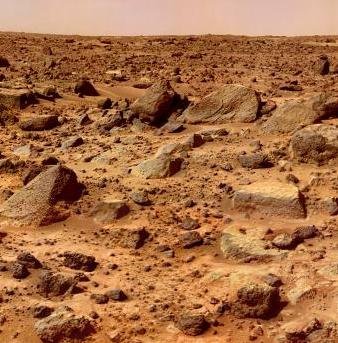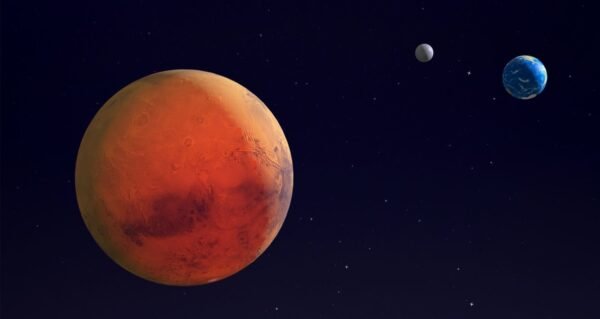Mars, the fourth planet from the Sun, has long captured the imagination of humanity as a potentially habitable world and a target for exploration. Often referred to as the “Red Planet” due to its rusty hue, Mars boasts a diverse array of surface features and holds valuable clues about the history and potential for life beyond Earth. Dive into the mysteries and allure of Mars in this comprehensive guide.
Introduction
• Mars, the fourth planet from the Sun, lies at an average distance of approximately 227.9 million kilometers (141.6 million miles).
• Its reddish appearance is due to iron oxide, or rust, covering much of its surface, giving rise to its nickname, the “Red Planet.”
Formation
• Mars, like Earth and the other planets in our Solar System, formed around 4.6 billion years ago from the solar nebula, a cloud of gas and dust left over from the formation of the Sun.
Physical Characteristics
• Mars has a diameter of approximately 6,779 kilometers (4,212 miles), making it roughly half the size of Earth.
• Its mass is about 10.7% that of Earth’s, and its gravity is about 37.6% of Earth’s, resulting in a weaker gravitational pull on its surface.
Atmosphere and Climate
• Mars has a thin atmosphere composed mainly of carbon dioxide (about 95.3%), with nitrogen (2.7%), argon (1.6%), and traces of oxygen and water vapor.
• Surface temperatures on Mars vary widely, ranging from as low as minus 195 degrees Fahrenheit (minus 125 degrees Celsius) at the poles to a maximum of around 70 degrees Fahrenheit (20 degrees Celsius) near the equator during the summer months.

Surface Features
• Mars is renowned for its diverse surface features, including vast plains, towering volcanoes, deep valleys, and polar ice caps.
• The planet’s most prominent features include Olympus Mons, the largest volcano in the Solar System, and Valles Marineris, a system of canyons stretching over 4,000 kilometers (2,500 miles) long.
Geological Activity
• While Mars lacks the tectonic activity seen on Earth, evidence suggests that it was once volcanically active and may still experience occasional volcanic eruptions.
• Recent discoveries, such as recurring slope lineae (dark streaks on Martian slopes), suggest the presence of liquid water beneath the surface, hinting at potential subsurface geological activity.
Rotation and Orbit
• Mars rotates on its axis at a similar rate to Earth, with a day lasting approximately 24.6 hours.
• Its orbit around the Sun takes about 687 Earth days, resulting in Martian years that are nearly twice as long as Earth years.

Facts about Mars
| Attribute | Mars |
| Size | 0.53 Earths |
| Diameter | 6,779 kilometers |
| Mass | 6.417 × 10^23 kg (0.107 Earths) |
| Aphelion | 1.666 Astronomical Units (AU) |
| Perihelion | 1.381 AU |
| Gravity | 0.376 times Earth’s gravity |
| Orbital Period | 687 Earth days |
| Rotational Period | 24.6 Earth hours |
| Surface Temperature | −195 to 70 °F (−125 to 20 °C) |
| Atmosphere Composition | 95.3% carbon dioxide, 2.7% nitrogen, 1.6% argon, traces of oxygen and water vapor |
| Surface Features | Volcanoes, canyons, impact craters, polar ice caps |
| Geological Activity | Past volcanic activity, potential subsurface water |
| Magnetic Field | Weak magnetic field |
| Rings | None |
| Moons | 2 (Phobos and Deimos) |
Learn more: Mercury: Solar System’s Smallest Planet – The Science Notes
Venus: Solar System’s Hottest Planet – The Science Notes
Exploration
• Mars has been the subject of numerous space missions, including NASA’s Mars rovers Spirit, Opportunity, Curiosity, and Perseverance, as well as orbiters like MAVEN and the European Space Agency’s Mars Express. These missions have provided invaluable data about Mars’ atmosphere, geology, and potential for past or present life.
• Future exploration efforts aim to delve deeper into Mars’ mysteries, including the search for signs of past life, understanding its geology, and preparing for future human exploration.
Mars continues to captivate scientists and enthusiasts alike with its potential for harboring life and its striking resemblance to Earth in many ways.
• Continued exploration of Mars promises to unlock further insights into the planet’s past, present, and future, paving the way for potential human settlement and expanding our understanding of the Solar System.
Comparison between Earth and Mars
| Characteristic | Earth | Mars |
| Size | Approximately 12,742 km in diameter | Smaller, about 6,779 km in diameter |
| Distance from the Sun | About 149.6 million km | Average distance of about 227.9 million km |
| Atmosphere | Mostly nitrogen (about 78%) and oxygen (about 21%) | Thin atmosphere, mostly carbon dioxide (about 95.3%) with nitrogen and traces of other gases |
| Surface Temperature | Average surface temperature around 14°C (57°F) | Variable temperatures ranging from -195 to 70 °F (-125 to 20 °C) |
| Surface Features | Diverse, including oceans, mountains, and continents | Volcanoes, canyons, impact craters, polar ice caps |
| Moons | One natural satellite, the Moon | Two small moons, Phobos and Deimos |
| Magnetic Field | Strong magnetic field | Weak magnetic field |
| Rotation and Orbit | Rotates once every 24 hours, orbits the Sun once every 365.25 days | Rotates once every 24.6 hours, orbits the Sun once every 687 Earth days |
FAQs on Mars
Q: What is Mars?
A: Mars is the fourth planet from the Sun in our Solar System, named after the Roman god of war.
Q: How far is Mars from the Sun?
A: Mars orbits, on average, about 227.9 million kilometers (141.6 million miles) from the Sun.
Q: How does Mars compare in size to Earth?
A: Mars is smaller than Earth, with a diameter of approximately 6,779 kilometers (4,212 miles).
Q: What is a day like on Mars?
A: A day on Mars, defined as one rotation on its axis, lasts about 24.6 Earth hours, similar to a day on Earth.
Q: What is the atmosphere of Mars composed of?
A: Mars’ thin atmosphere is mostly carbon dioxide (about 95.3%), with traces of nitrogen and other gases.
Q: What is the surface temperature of Mars?
A: Mars experiences variable temperatures, ranging from as low as minus 195 degrees Fahrenheit (minus 125 degrees Celsius) to about 70 degrees Fahrenheit (20 degrees Celsius).
Q: Does Mars have any moons?
A: Yes, Mars has two small moons named Phobos and Deimos.
Q: Why is Mars called the Red Planet?
A: Mars is often referred to as the Red Planet due to the iron oxide, or rust, covering much of its surface, giving it a reddish hue.
Mercury: Solar System’s Smallest Planet – The Science Notes